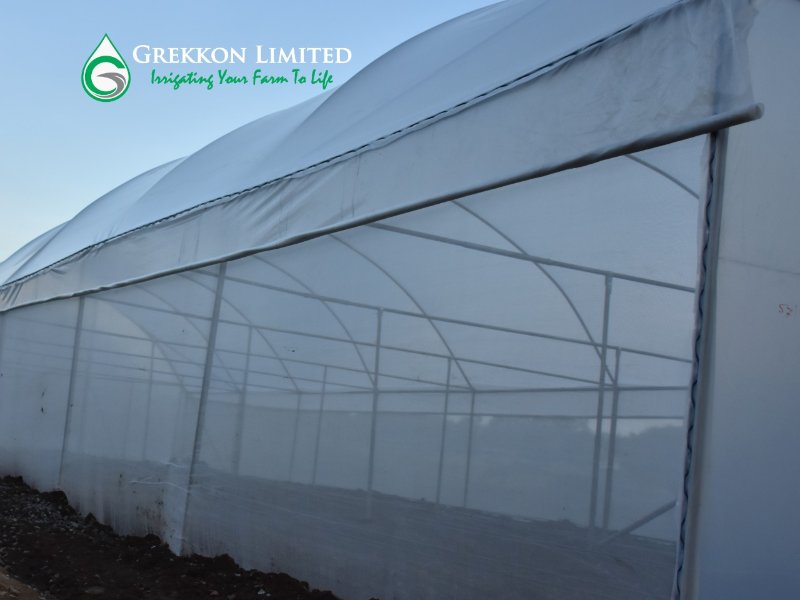
Affordable Greenhouses In Kenya
As a greenhouse company in Kenya, our affordable greenhouses in Kenya vary depending on the size, design, choice of crop, and the level of the steel frame treatment. In every project we undertake to create steel frame affordable greenhouses in Kenya, our price is pegged on these 3 considerations Size. Greenhouse sizes and prices are […]

Greenhouse Paper In Kenya
Grekkon Limited’s greenhouse paper in Kenya is of various rent characteristics. These characteristics determine it’s overall performance on the crop. The paper choice is the same irrespective of the greenhouse type by shape, or by structural material. Our greenhouse paper price in Kenya is Kes 96/M sq irrespective of the polythene properties
Greenhouse Paper In Kenya; Properties
- Thickness. 200 microns/ 0.2mm
- Colour . Clear or yellow
– clear paper allows more light. This is good for fruiting crops such as tomato, strawberry, capsicums, and peppers. This is because more light has higher photosynthesis, which equates to more food for the plant. It is necessary for bi-color or multi -color flowers to enhance the different colors

– yellow paper will be for leafy vegetables, herbs, spices, and mono color flowers. These require less food as they are not fruiting
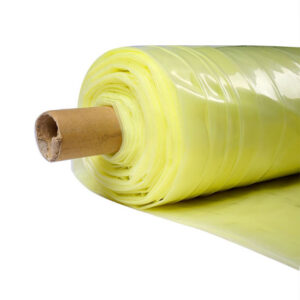
3. Width 5.5M, 8M, 16M. This not split but supplied as such to the grower
4. Roll length of 100M. The roll is cut as per client’s ordered length
5. UV treated. UV treatment blocks off excess UV light which in turn enhances the greenhouse paper lifespan. Our UV treatment is for 3 years/ 36 months. This warranty is on the paper
6. Anti-drip properties. Anti drip treatment prevents dew drop lets from forming on the greenhouse paper. Dew formation is as a result or crop respiration which releases moisture from the plant. Dew droplets falling or crops in the greenhouse pr-dispose the crop to fungal infections. The droplets also refract light, limiting the amount of light falling on the crop
How to choose your greenhouse polythene
- By crop. Is it a leafy or fruiting vegetable? Is is s mono or bi/ multi-coloured flower? This determines the paper color
- By width. There are different widths to choose from based on your greenhouse structure size
When the greenhouse paper tears, we provide a greenhouse repair tape that has the same characteristics as the greenhouse paper
FAQs
I. How much is greenhouse polythene in Kenya?
Greenhouse polythene price in Kenya
| Price | Treatment |
| Kes 95/M sq | With anti -UV only |
| Kes 120/M sq | With additional anti-drip treatment |
II. What plastic can be used for greenhouse?
Yellow or clear plastic are the choices for a greenhouse cover
III. What is the best poly for a greenhouse?
As explained above, the right greenhouse plastic depends on the crop type
IV. How do you attach polythene to a greenhouse?
For a metallic greenhouse, steel profiles and wiggle wires secure the paper against the steel frame
V. How long does polythene last on a greenhouse?
Our anti-UV block treatment is guaranteed for 36 months use. However, the paper itself will last for 5 years
VI. How thick should greenhouse poly be?
200 to 220 micron
VII. How often do you replace greenhouse plastic?
We recommend every 3 years so which is when the anti-UV block ceases
How to Keep Your Greenhouse Polythene Tight
- Spread out the paper on the greenhouse structure early in the morning or late in the evening when he temperature is below 20 degrees celcius. If it’s too hot, the paper will tear on contraction when it gets cold. If it’s too cold, the paper will sag when the temperature rises
- Roll it or pull it from one end to the next frame or runner and secure it with a profile and wiggle wire. Then stretch it again for this point to the next and so on
- Avoid covering in the afternoon when it is very windy as this will cause the paper to tear
How To Maintain Your Greenhouse Sheet
Observing these habits will keep your greenhouse polythene price in Kenya at the barest minimum
- Have a greenhouse tape for minor repairs when the paper is torn. Grekkon Limited’s greenhouse tape is UV resistant, trans-parent and is designed for outdoor use
- Clean your greenhouse cover monthly to prevent algae, moss, and dust which inhibit light from shining through
- Change it at the right time, which is when the anti-UV treatment expires
Caution: Do not use your greenhouse polythene in awater pan or tank to store or harvest irrigation water
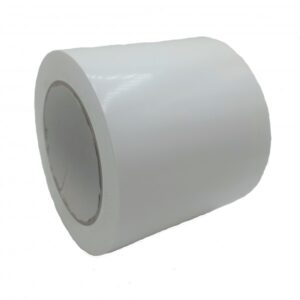
Greenhouse repair tape. It has the same qualities as the greenhouse paper
Greenhouse polyethylene price in Nairobi
This is Kes 96/ M sq in Nairobi and all our up country branches
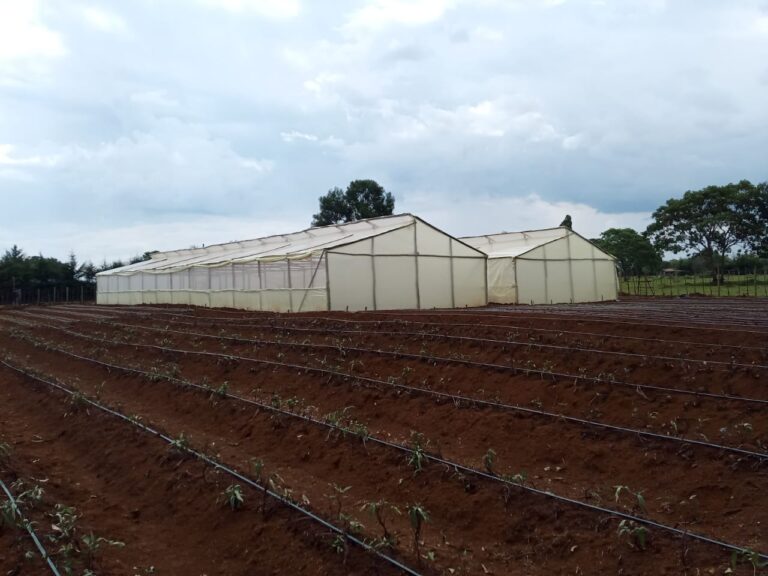
Wooden Greenhouse Prices in Kenya
Wooden greenhouse prices in Kenya by Grekkon Limited are by size and choice of timber. This low cost greenhouse construction in Kenya takes the same amount of time to build as metallic greenhouses. In our local greenhouse construction, we include the following components A sanitary pouch. This is for disinfection of hands and feet as […]
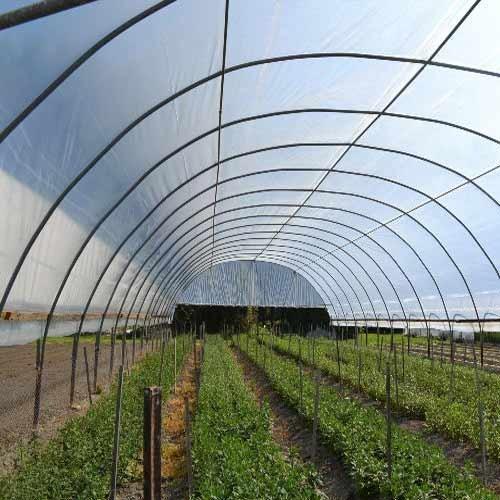
Greenhouse Company In Kenya
Grekkon Limited is the low cost premier greenhouse company in Kenya, known for its galvanised steel tunnel type, and open ventilation type units. We provide affordable greenhouses in Kenya with each unit constructed tailored to the grower’s specifications.
There is a choice of wooden or metallic greenhouses from our choice of low cost greenhouse construction in Kenya. All greenhouse sizes unit have a drip irrigation system installed, with water supplied via a HDPE pipe
How To Construct A Greenhouse
- Assessment of the location. Is it high, mid or low altitude? Tunnel type units are for the highlands and cooler areas. Open ventilation type units for the warm mid to coastal locations
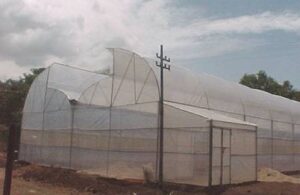
Open ventilation type greenhouse
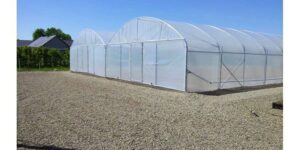
Tunnel type greenhouses
2. Check the land topography, and water availability. This determines the greenhouse location
3. Understand the target crop type.
This informs us if the unit will have an internal crop support system, and how strong it should be. A strawberry greenhouse will need none, but a tomato or pepper unit will. It advises on the greenhouse net to install. Strawberry and tomato will have different nets on the sides
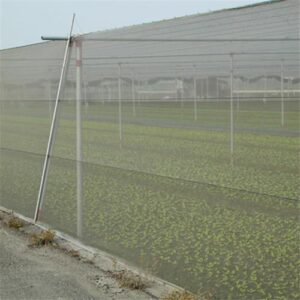
An insect net on the side to keep away pests
4. Material selection.
- Galvanised steel. Galvanisation keeps it from rust
- UV treated greenhouse polythene with anti-drip properties. UV treatment prevents rapid sun degradation, anti- drip treatment prevents dew formation on the paper. Dew drops falling on the crop are a precursor to fungal diseases. It covers the top and sides of a greenhouse structure to protect the plants within from the elements. It allows in the right spectrum of light for crop growth while filtering away the less needed part of light by the crop. All this creates a an internal environment favourable to plant growth regardless of the external environment. This allows for all year production, improves crop yield and quality
- UV treated insect/ bird net. The former keeps away insect pests, while the latter allows in insects for pollination, but prevents entry of bird pests
- Stainless steel profiles and plastic coated wiggle wires hold the greenhouse paper and netting onto the steel frame
As a greenhouse company in Kenya, the above are the key considerations we make when advising growers on the choice of greenhouse units
Greenhouse Prices In Kenya
1. Metallic
| Greenhouse Type | ||||
| Tunnel Type | Open Ventilated Type | |||
| Greenhouse Size | 15M x 8M | 290,000 | 330,000 | |
| 20M x 8M | 300,000 | 340,000 | ||
| 24M x 8M | 320,000 | 350,000 | ||
| 30M x 8M | 460,000 | 540,000 | ||
| 40M x 8M | 575,000 | 655,000 | ||
| 15M x 16M | 460,000 | 555,000 | ||
| 24M x 16M | 620,000 | 665,000 | ||
| 30M x 16M | 900,000 | 990,000 | ||
| 40M x 16M | 1,100,000 | 1,240,000 | ||
2. Wooden
| Dimensions in meters | Tomato Crop Population | Price in KES |
| 15 x 8 | 600 | KES 140,000 |
| 24 x 8 | 800 | KES 160,000 |
| 30 x 8 | 1,200 | KES 190,000 |
| 30 x 16 | 2,500 | KES 370,000 |
How To Construct Timber Greenhouses
i. Know the crop type to plant. This will guide on the greenhouse design and amount of material to use. For instance, a tomato greenhouse will take more material than one with herbs. This is because tomato will require training, and herbs won’t. It also guides on the greenhouse paper to cover with. You will have more light for fruiting crops like tomato, capsicum, chilli, cucumber, and strawberry, or bi/ multicolored flowers. Have a clear polythene for these. Mono-color flowers will have the yellow polythene cover
ii. Determine the plant population you need. This informs the area of the greenhouse
iii. Once you determine the amount of timber required based on the greenhouse area, treat it. This is to prevent weevils and termites from attacking the timber which reduces it’s lifespan. Do not apply motor oil on the timber as treatment. This is because it will contaminate food crops in the greenhouse
iv. Your construction design is the vented type. This is because the wood cannot be curved to a tunnel type design
v. Cover the roof and side ventilation with an insect net. Select the high density gauge which is effective in keeping away white-flies
vi. Make the beds according to the crop type. Beds are important in managing drainage. For seedling production, set up the tables 1M high
vii. Set up the drip irrigation system on the beds. For seedling production, set up he misting or fogging system above. The misters or foggers are 1M apart
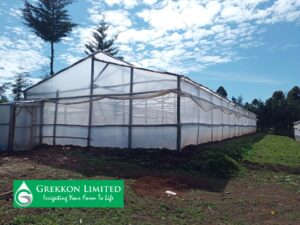
A wooden greenhouse by Grekkon Limited
How to Choose Greenhouse Nets
Greenhouse nets allow for ventilation of the crops, and personnel working in the unit. Below are the consideration made when deciding the choice of greenhouse net to install on the sides
1. Crop type. Some crop types require higher light intensity than others. In this case, a lower shade % net is appropriate for the former. Fruiting crops such as; tomato, strawberry, capsicums, and so on require more light than leafy vegetables. Examples are; cabbage, spinach, collards, kale etc.
2. Crop stage of growth. The shade net in the nursery will block out more heat, than the one for established crops in the field
3. Location of the farm. In the highlands where the heat intensity is less, a lower shade net will protect crops well. In the mid to low altitudes where it’s hotter, a higher shade net works best.
4. Latitude. Countries such as Kenya lie along the equator where solar radiation is high. Your choice of greenhouse net will have higher UV treatment than that of a temperate region

A bird net on a strawberry greenhouse to allow in insects for pollination, while keeping away bird pests
Greenhouse Company In Kenya
FAQs
a. What materials are needed to build a greenhouse?
- UV treated greenhouse polythene
- Steel pipes
- Insect netting
- Profiles and wires
b. Can I grow year-round in a greenhouse?
Yes because the crop is protected from the elements of weather
c. Do greenhouses make money?
Yes they do with a high-value crop
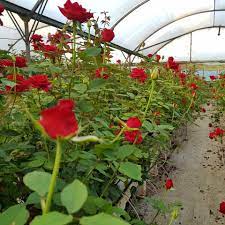
Low Cost Greenhouses In Kenya
Our low cost greenhouses in Kenya are either wooden or metallic in structure, vented or tunnel in shape. Internally, they will or will not have crop support systems, and the steel will be galvanised or painted with a protective coat
These low cost greenhouse construction in Kenya attributes are explained in detail below:
- Greenhouse size; the larger it, the lower the unit area cost
- Greenhouse material type. Wooden greenhouses are cheaper than steel frame greenhouses, because steel is more costly. However, they have a shorter lifespan

A low cost wooden greenhouse in Kenya by Grekkon Limited
3. Greenhouse design. Tunnel type greenhouses are lessor priced than vented types. The former are for cool highland locations so that they retain heat, while the latter are for hot locations for less build up of heat

Tunnel type greenhouse
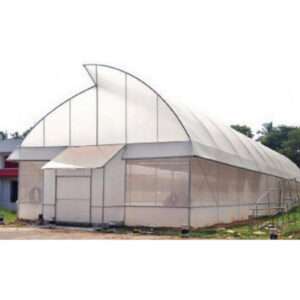
A vented type greenhouse structure
4. Greenhouse use. Is it for flowers, vegetables, strawberry, herbs and spices or seedlings production? This influences the infrastructure set up within the greenhouse. Crops that do not require a greenhouse with an internal crop support system such as; strawberry, herbs, and spices have lower greenhouse construction costs
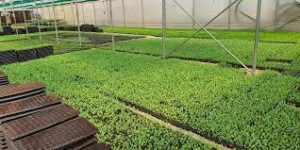
Seedlings production in a greenhouse
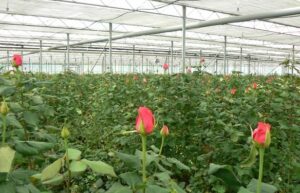
Roses production in greenhouse
5. Steel treatment type. To lower the cost of the greenhouse structure, some growers opt for steel painted with an aluminum or zinc coating. This is less costly than the zinc galvanised steel. However, the paint wears out over time and the greenhouse frame is repainted to prevent rust
As the leading greenhouse company in Kenya, we utilise local greenhouse construction techniques. Our low cost greenhouses in Kenya are for such crops as; roses, carnations, tomato, capsicums, strawberry, and assorted herbs and spices
I. Low Cost Greenhouses in Kenya
1. Greenhouse price in Kenya: Tabulation of steel types
| Greenhouse Type | ||||
| Tunnel Type | Open Ventilated Type | |||
| Greenhouse Sizes | 15M x 8M | 290,000 | 330,000 | |
| 20M x 8M | 300,000 | 340,000 | ||
| 24M x 8M | 320,000 | 350,000 | ||
| 30M x 8M | 460,000 | 540,000 | ||
| 40M x 8M | 575,000 | 655,000 | ||
| 15M x 16M | 460,000 | 555,000 | ||
| 24M x 16M | 620,000 | 665,000 | ||
| 30M x 16M | 900,000 | 990,000 | ||
| 40M x 16M | 1,100,000 | 1,240,000 | ||
2. Low cost wooden greenhouse prices
| Greenhouse sizes | Tomato Crop Population | Price in KES |
| 15 x 8 | 600 | KES 155,000 |
| 24 x 8 | 800 | KES 200,000 |
| 30 x 8 | 1,200 | KES 250,000 |
| 30 x 16 | 2,500 | KES 400,000 |
II. How much does it cost to install a greenhouse in Kenya?
Every tabulated greenhouse price in Kenya above by Grekkon Limited covers both the material and labor cost of greenhouse construction or installation
III. How profitable is greenhouse farming in Kenya?
Every low cost greenhouse for sale in Kenya procured for crop production is a significant investment for the farmer. To optimise revenue and ensure profitability, a grower will adhere to the following
1. Conduct a complete soil test. This will guide the farmer on 2 things
- the right crop nutrition regime
- and the suitability of that soil to establish a greenhouse in regards to any existing soil pests and diseases
2.Choose the right seed. Whatever crop you choose to grow, select the best yielding greenhouse varieties
3. Crop type. The value of the final produce according to market preference
4. Right greenhouse structure. This will be determined by the greenhouse location. Is it a vented or tunnel design?
5. Proper greenhouse polythene color and specs. Follow this guideline
- Yellow polythene is for mono color flowers or none fruiting crops which produce well under lower light intensity
- Clear polythene is for bi or multi colored flowers and any fruiting crop which requires higher light intensity for photosynthesis
- It will have UV treatment to last for long, and to block strong UV rays from reaching the crop
- It will be treated for anti-drip qualities. This prevents dew from forming on the paper and dripping on the crop causing disease infection
6. Irrigation management. As an irrigation company, we provide a detailed irrigation regime tailored to the crop type and growth stage
7. Disease and pest management.
- Have a sanitary pouch at the entrance to sanitize feet, and hands
- Limit access to the greenhouse to a few people
- Daily scouting for pests and diseases
- Have a scheduled pest and disease spray program
